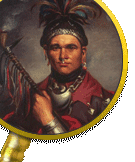The first people to live in Pennsylvania were part of the earliest waves of human migration into the Western hemisphere. William Penn and his fellow colonists upon their arrival encountered native inhabitants who had their own name for this land and their own starting point for its history.
Continue the Story...
Bring this subject into focus through the following chapters. These stories take exploration of the main story further by providing more detail for you to learn and explore.
Take your students back in history with these discussions and activities for the classroom
|
700 - 1300 |
Mississippian Culture: last mound-building peoples in western Pennsylvania/Ohio Valley. |
|
|
1000 - 1500 |
Late Woodland Period: distinct cultural groups inhabit Pennsylvania's
major river systems: Delaware, Susquehanna, and Allegheny-Ohio.
|
|
|
1500 - 1600 |
European trade goods first appear in Pennsylvania archaeological sites, probably arriving by way of trade between coastal Indian peoples
and early European explorers and traders.
|
|
|
1608 |
Captain John Smith encounters Susquehannocks in northern
Chesapeake Bay.
|
|
|
1620 |
Dutch fur traders based in New Netherland (New York) build posts on
Delaware River.
|
|
|
1638 |
Swedes establish colony of New Sweden on Delaware River. |
|
|
1682 |
William Penn founds Pennsylvania. |
|
|
1690 - 1740 |
Indian peoples displaced by colonization of eastern seaboard resettle in northern Delaware, Susquehanna, and Allegheny-Ohio valleys. |
|
|
1737 |
Walking Purchase: Penn family's fraudulent acquisition of Forks
of Delaware region (modern Easton-Bethlehem).
|
|
|
1740 |
Presbyterian and Moravian missionaries seek converts among Indians
living at Forks of the Delaware and northern branch of Susquehanna
River.
|
|
|
1744 |
Treaty of Lancaster: Iroquois of New York release their claim on
Ohio Country to Virginia.
|
|
|
1753 |
Carlisle Treaty: Ohio Indians seek assistance from Pennsylvania
government in resisting French intrusion into Ohio Country.
|
|
|
1754 |
Albany Congress Treaty: Penn family's agents purchase from Iroquois
of New York lands west of Susquehanna River, including Juniata Valley.
.At same treaty conference, Susquehanna Land Company of
Connecticut purchases from Iroquois northern branch of Susquehanna
River (Wyoming Valley).
|
|
|
1755 - 1758 |
Frontier warfare extends from Northampton County to Monongahela
Valley.
|
|
|
1755 |
Braddock's Defeat on his approach to Fort Duquesne starts French
and Indian War (also known as Seven Years" War) in Pennsylvania.
|
|
|
1758 |
Treaty of Easton: In exchange for Penn family's agreement to
relinquish some of the western territory acquired at Albany Treaty
in 1754, Delaware and other western Indians agree to cease their
alliance with the French, making possible success of the Forbes
Expedition and the fall of Fort Duquesne.
|
|
|
1763 |
Paxton Boys" massacre of Conestoga Indians. |
|
|
1763 - 1764 |
Pontiac's War: Ohio Indians wage war against British soldiers and
settlers for their failure to vacate the Ohio Country as promised
after the removal of the French.
|
|
|
1768 |
Treaty of Fort Stanwix: Iroquois of New York agree to cession of lands
in Pennsylvania extending from Wyoming Valley to Forks of the Ohio.
|
|
|
1774 |
Lord Dunmore's War: Virginia's royal governor prosecutes war against
Chief Logan and Ohio Valley Shawnee to force cession of modern
Kentucky.
|
|
|
1775 - 1783 |
American Revolution: Indians in western Pennsylvania and New York,
allied with British and American loyalists, war with Pennsylvanian
militiamen and Continental Army.
|
|
|
1778 |
Battle of Wyoming: Most devastating Indian attack in Pennsylvania
during the Revolution empties the Wyoming Valley of settlers.
|
|
|
1779 |
Sullivan Expedition: Undertaken by Continental Army as reprisal
for Battle of Wyoming and to break the power of Iroquois in western
New York
|
|
|
1782 |
Massacre of ninety-six unarmed Moravian Indians at Gnadenhutten in Ohio
Country by Pennsylvania militiamen from Pittsburgh area.
|
|
|
1784 - 1794 |
Post-Revolutionary treaties between United States government
and Iroquois and Ohio Indians complete Indian land cessions of
territory within Pennsylvania's borders.
|
|
|
1791 - 1795 |
Ohio Indian Wars: continued resistance by Indians against U.S.
expansion in western Pennsylvania and Ohio Country, ended by
Battle of Fallen Timbers in 1794 and Treaty of Greenville in 1795.
|
|
|
1818 |
John Heckewelder publishes: History, Manners, and Customs of the
Indian Nations who once inhabited Pennsylvania and the
Neighboring States.
|
|
|
1832 |
George Catlin begins career painting Indians of trans-Mississippian
West.
|
|
|
1879 - 1918 |
Carlisle School leads boarding school movement for Indian education
in the United States.
|
|
|
1964 |
Seneca Indians living on the Cornplanter Tract in the northwest
corner of the state lose their land with construction of the Kinzua
Dam on the Allegheny River. The Cornplanter Seneca move north
to other Seneca communities in New York State.
|
|
|
2000 |
U.S. Census counts 52,650 Pennsylvanians who identify their heritage as all or part Native American. |
|









